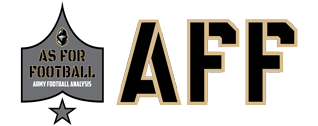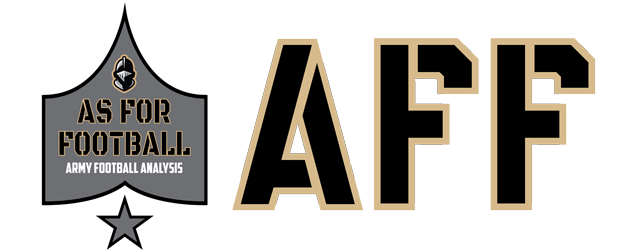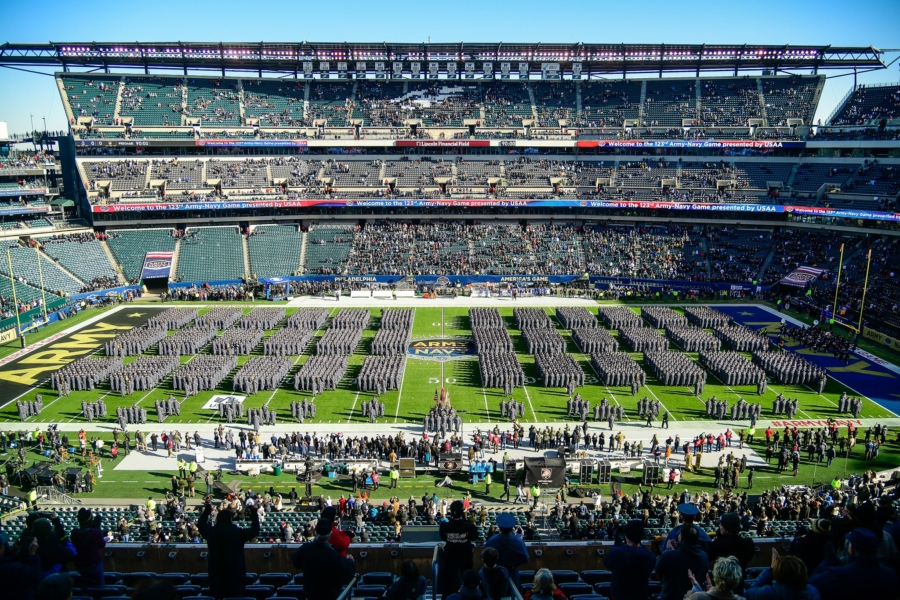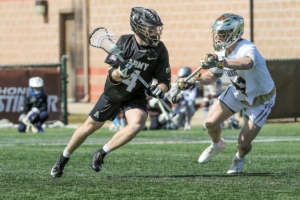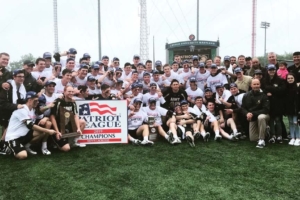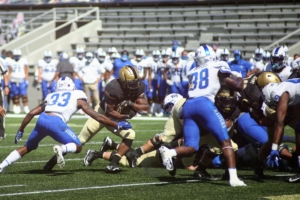It’s that time of year again. With no bowl bid, Army Football’s 134th season will come to a close the same way so many others have — with the Army-Navy Game.
In addition to the Secretary’s Trophy, Army has the opportunity to secure its fourth Commander in Chief’s Trophy during the Monken Era. Doing so would make this particular trophy the definition of parity over the last 13 years by giving each academy 4 wins with one shared.
Good morning Army fans ☀️
— Army Football (@ArmyWP_Football) November 22, 2023
🔗 https://t.co/E23tIbEUHh#GoArmy x #ROTM pic.twitter.com/yYZSAorXJG
Navy Midshipmen
The Mids are led by first-year head coach and former defensive coordinator Brian Newberry. The last time Navy hired a head coach who was previously a defensive coordinator at any school? Way back in 1982 with Gary Tranquill.
On the offensive side, Navy brought in Grant Chestnut, who had been running the triple option at Kennesaw State for former Paul Johnson assistant Brian Bohannon. Chestnut actually played for Paul Johnson and his assistant Jeff Monken while a student at Georgia Southern.
Offensive Scheme
Navy’s offense has seen a little bit of everything this year. They’ve run plays from three general formations: the traditional flexbone, the pistol/shotgun, and with split running backs, one on either side of the quarterback. The formation variance isn’t new to Navy’s offense, though the split backs formation is unique to recent triple-option football. What is new is how Navy is treating its position players. In that regard, OC Grant Chestnut has been blurring two lines this year:
1. The line between a slotback and a wide receiver. This is not exactly a novel concept, but Navy has utilized their slotbacks in the passing game an awful lot this year. Slotbacks produced a whopping 59% of passing yards while only 28% came from the wide receivers. That’s almost the exact opposite of what we saw a year ago.
2. The line between a dive-back and a pitch-back. Traditionally, option teams utilize fullbacks who are heavier but slower for the Dive option. They then use slender, faster slotbacks for the Pitch option and perimeter opportunities. Navy has blurred this line pretty hard this year, however, using their heavier fullback-style players for both types of running. This can get a bit confusing because of how Navy lists players on its roster, but to illustrate the point, running backs who weighed 195+ lbs. constituted 46% of all rushing production last year, while players who weighed under 195 made up 27%. This year, the heavy group accounts for 57%, while the lighter group accounts for just 9%.
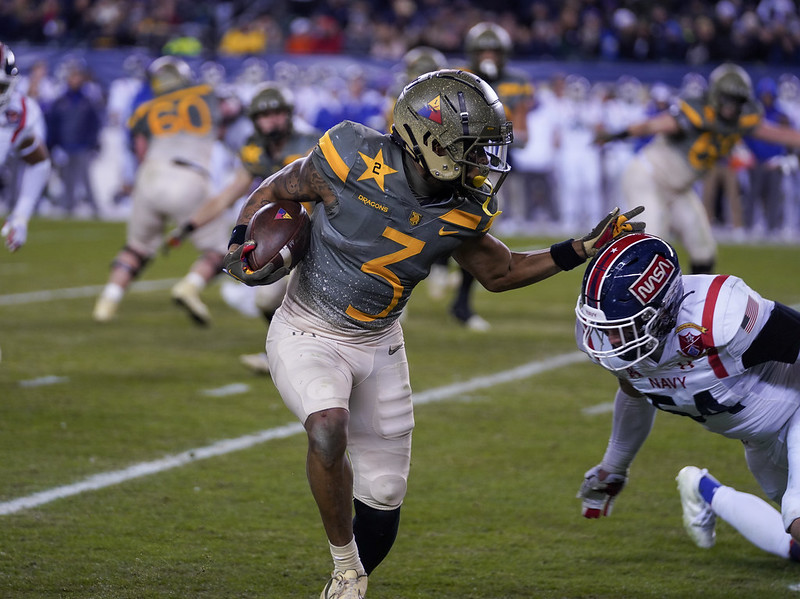
Injuries
Navy has seen a revolving door at quarterback this year. Coach Newberry has started four different guys under center: Tai Lavatai, Blake Horvath, Braxton Woodson, and Xavier Arline. Horvath went down with a thumb injury against North Texas and hasn’t been back. Lavatai went down with a calf injury against Air Force and also hasn’t returned. Xavier Arline, who has started the last four games, went down against Southern Methodist with a leg injury. He did make a brief reappearance before exiting that game entirely in the first half. Woodson then came in and went the rest of the way. Technically, we could see any or all of those guys on December 9th. However, Arline is probably the odds-on favorite to start.
The wide receivers’ room in Annapolis has also seen its share of injuries. WRs Jayden Umbarger and Regis Velez both went down during the SMU game. Unfortunately, we don’t have a report on whether they’ll be available or 100% on gameday. Meanwhile, WR Nathan Kent, the most productive Navy receiver this year, hasn’t recorded a reception since the North Texas game way back in early October.
Passing
Navy’s passing game looks significantly better this year. Specifically, Xavier Arline has looked good throwing the ball for the first time in his career. He completed more passes in his first three starts this year than in his entire freshman, sophomore, and junior seasons combined. Yes, some of that is due to the schematic shift in Navy’s offense. Even so, in those three games, he completed 66% of his passes for 320 yards. That marks a massive improvement, though he cooled off a bit against SMU, going 0/6.
More to the point, Navy threw the ball 29 times against Air Force! If we include sacks as “passing plays,” Navy called more passes than runs!! They came up with 102 passing yards to show for it, but when paired with just 22 rushing yards, the Mids’ offensive output was never going to win that game.
It’s not out of the question that Coach Chestnut would throw that much again. But considering how it went in October, the more likely game plan includes fewer dropbacks*. For reference, last year Coach Niumatalolo called just 4 passing plays against Army.
* Editor’s Note: I am absolutely expecting Navy’s new coaching staff to attempt a bunch of passes. In fact, if you want a high-payout prop-bet that actually has some basis in reality, take Army S Quindrelin Hammonds as your game MVP.
All about the details. #GoArmy x #ROTM pic.twitter.com/AsDgKkXEXN
— Army Football (@ArmyWP_Football) November 22, 2023
Scoring
Navy has been scoring unlike any option team in recent history. It’s not that they’re scoring a lot of points or a little, but rather how they’re scoring. Generally speaking, Navy doesn’t score on long, drawn out drives.
To illustrate this point, we’re going to invent a new statistic and sort all regulation TD drives into 3 categories:
| Turnover TD Drive (TTD) | A touchdown drive that originates from a turnover or a turnover on downs |
| Explosive TD Drive (ETD) | A touchdown drive that is not a TTD where the offense averages 10 yards/play or more |
| Blunt-Force TD Drive (BTD) | a touchdown drive that is not a TTD where the offense averages fewer than 10 yards/play |
Typically, option-teams run their offenses with the intent to score via BTD. Sometimes big plays happen and offenses achieve an ETD, and there’s nothing wrong with that! However, the objective of each play is to stay on-schedule. Being on-schedule allows an option team to run the ball more times, which in turn gives the opposing defense more opportunities to make a costly mistake as they grow tired.
As a frame of reference, the vaunted 2018 Army offense had 26 BTDs, 10 TTDs, and 8 ETDs going into Army-Navy. This year, even with Army’s struggles, the totals are 13 BTDs, 6 TTDs, and 6 ETDs. The Black Knights have scored fewer total touchdowns in 2023, but they are still scoring them in the same way they did in 2018, generally speaking.
This year, Navy has had 5 BTDs, 9 TTDs, and 11 ETDs. That’s a completely new makeup. Further, 3 of the 5 BTDs came against North Texas, who owns the very worst rushing defense in the entire FBS. Traditionally, option teams score approximately 50% of their touchdowns via BTD. This year, Navy is at just 20%. Moreover, 55% of all Navy touchdown drives come from ETDs.
They may not score as often, but they often score fast.
Redzone Performance
It’s time to invent another new statistic! If you’ve seen redzone percentage on TV or via the computer, it’s a very simple equation:

But that’s not really what we want to know. Instead, we’d really like to know how many points an offense scored or defense allowed on average for each redzone opportunity. We are therefore going to evaluate redzone performance with a new statistic called redzone points percentage or RZP%.
The formula is:

In this stat, the numerator is how many points were actually scored, while the denominator is the number of points that could have been scored. Notice that we assume every field goal attempt is made and that every touchdown ends with a successful point-after-try. This is because offenses should not be punished and defenses should not be rewarded for special teams plays or for situational decisions to go for two.
Why does this matter?
Here are the RZP% for both Army’s and Navy’s offenses and defenses:
| RZP% | Army | Navy |
| Offense | 67% | 60.2% |
| Defense | 65.0% | 68.2% |
It may not seem like much, but the 3.2% advantage on defense and the 6.8% advantage on offense averages to be about 3.5 points/game. In a tight CiC game, getting an extra 3+ points is huge!
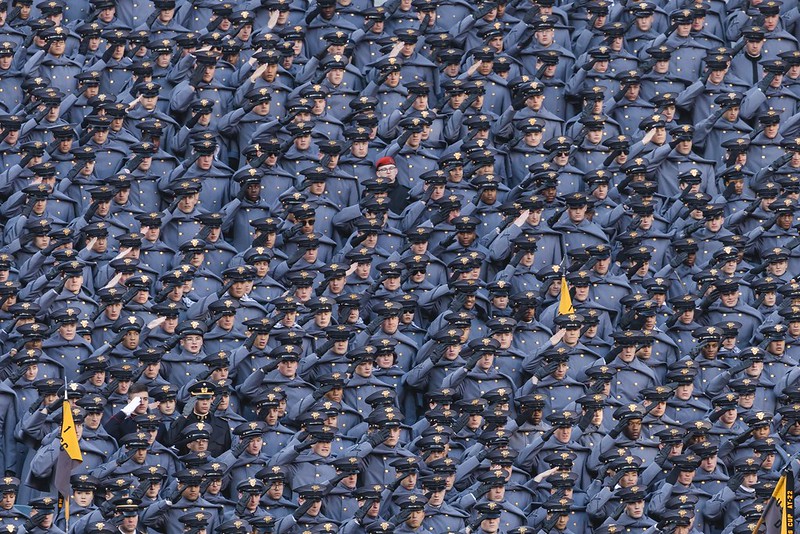
Navy’s Defense vs. Army’s Offense
One thing is certain: Navy will use several defensive formations in this game. In rewatching the Air Force game, Navy used four different formations in the first quarter. Then I got tired of counting. The most common formation was a 3-4, but they also ran a healthy mix of 4-3, 6-1, and even a 3-3 stack.
Air Force didn’t have a lot of success moving the ball, though. They had one explosive passing play break for a 94-yard touchdown. That play accounted for a majority of the offense’s points in part because the Falcons were 1/13 on third down. Air Force ended the day with more passing yards than rushing yards, but their passing yards came on just 5 plays, while they rushed the ball 48 times.
A successful game for Army’s offense probably looks similar.
We have no idea whether Army will line up in the new shotgun option, the traditional flexbone, or both. That’s probably by design. Moreover, with the SMU game, Navy has had just two weeks to prepare for Army’s offense instead of three. The fact that they’re preparing for two different offensive looks and two different playcallers makes that time crunch even more problematic.
Special Teams
This wouldn’t be a CiC preview without a note on special teams. As far as punting goes, Navy has the advantage for the second straight year. Last year, though, punting led to the Mids’ demise despite that advantage. We shouldn’t expect the same this year, but Army still has an outstanding punt-blocking unit, so STC Sean Saturnio may yet figure out how to get another one.
Army has the place kicking advantage this year. Navy switched to sophomore K Nathan Kirkwood during the Memphis game this year and hasn’t turned back. Kirkwood has been automatic inside of 40 yards, but he’s just 2/5 from 40+. His longest this season was 45 yards, but he missed from 42 and 44 with another 42-yard attempt that got blocked.
Would Navy try a 50 yarder with one second to go in the first half? Sure.
But in order to feel good about a kick, they’ll probably have to get very close to the redzone.
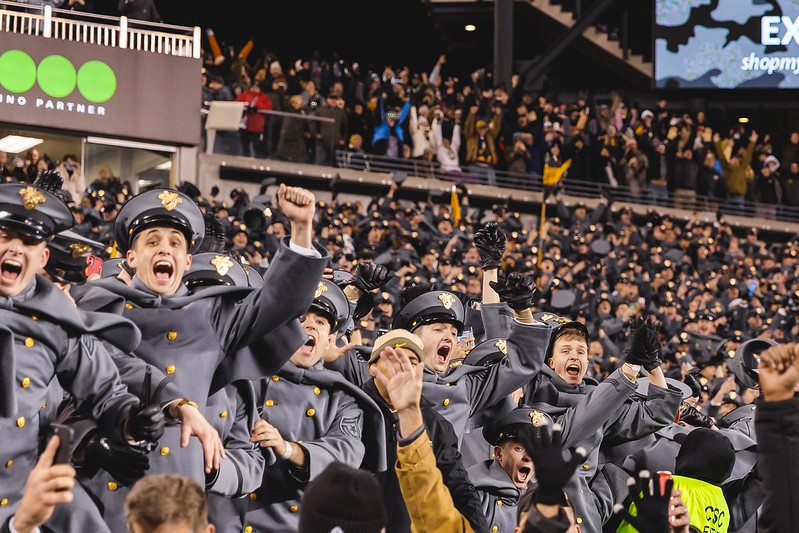
Keys to Victory
As is the usual with Keys to Victory, they’re true for any game. However, these specific Keys will be extra important on Saturday.
1. Don’t give the Navy offense a short field.
The Mids get over a third of their points off of turnovers. That’s a lot. So it’s not enough just to say, “Don’t turn the ball over.” This statistic potentially changes the calculus for things like going for it on 4th down.
Typically, Army will go for it on 4th-and-1 at the 50 yard line. In this game, pinning Navy deep might arguably be more important.
2. Don’t give up the explosive play.
All year long we’ve heard about the bend-don’t-break defense. Facing other offenses, this translates to giving up 8 yard passes to prevent 20+ yard passes. When facing an option offense, this means containing the quarterback on the perimeter and keeping running backs out of the third level. With the redzone advantage that Army possesses coupled to Navy’s inability to sustain long drives, the importance of Army’s defense keeping the ball in front of them will be at an all time high.
3. Win – or at least tie – the special teams battle.
Army may very well get another blocked punt this year, but they shouldn’t need one to be successful. However, a sub-20 yard punt from Army’s own side of the field could be devastating.
The Black Knights don’t need to be a 40+ yard punt every time, but they’ll have to avoid shanks. Then, force field goal attempts instead of giving up redzone touchdowns and put the pressure on Navy’s special teams to execute.
If this turns into a kicking contest, Army will have a distinct advantage.
A West Point reveal. #GoArmy x #ROTM pic.twitter.com/pPU5BX3TVF
— Army Football (@ArmyWP_Football) November 22, 2023
Final Thoughts
This game is the first game in the Boston Metro Area, and just the third outside of the NYC, Philadelphia, and Baltimore-Washington combined statistical areas. So if you’re heading up there, make sure to enjoy some clam chowder and the Freedom Trail in addition to game. The previous two non-traditional-city games ended with a Navy victory in Pasadena and a tie in Chicago, so some Army bragging rights are overdue.
The total for this game opened at 32.5. As of this writing, that total has dropped as low as 28. Army sits as about a 2-point favorite, so prepare your minds — and your stomachs — for another hard-fought slugfest.
The good news? If Army executes, this game is theirs to lose.
In addition to Vegas, each of the six BCS computer rankings favor the Black Knights. Army has shown its ability to force turnovers against a superior triple-option offense. Since the Coastal Carolina game, they’ve also proven that their offense can be an asset.
We know Coach Monken will have his guys ready. They just need to out-fight and out-execute, and we can all leave happy.
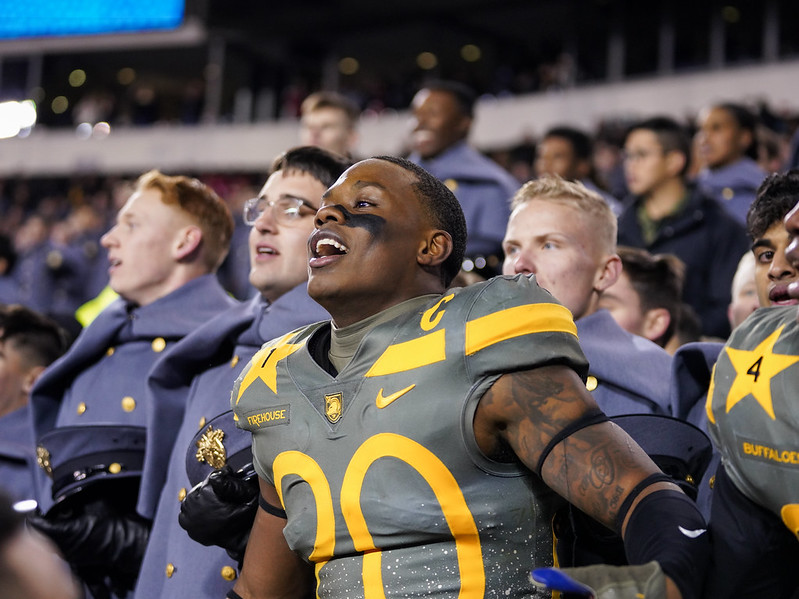
Go Army! Beat Navy!!!
All pictures via Flickr: West Point – The U.S. Military Academy, “2022 Army Navy Game: The 123rd Army/Navy football game takes place at Lincoln Financial Field in Philadelphia, Pennsylvania on 10 December 2022.“
